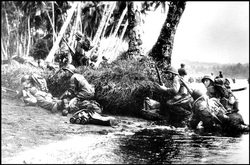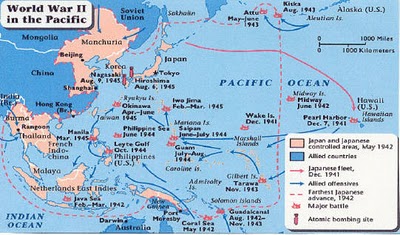Island hopping

“Island Hopping” is the phrase given to the strategy employed by the United States to gain military bases and secure the many small islands in the Pacific. The attack was lead by General Douglas MacArthur, Commander of the Allied forces in the South west Pacific, and Admiral Chester W. Nimitz, Commander-in-chief of the Pacific fleet. The US troops targeted the islands that were not as strongly defended by the Japanese. They took control of those islands, and quickly constructed landing strips and small military bases. Then they proceeded to attack other islands from the bases they had established. Slowly the US army moved closer to Japan, taking control of many of the surrounding islands.
MacArthur met with Admiral William “Bull” Halsey, and the two devised a plan. On April 26th, 1942, they laid out the plan; a two-pronged offensive codenamed “Cartwheel”. They aimed to corner Japanese troops on Rabaul Island, with MacArthur’s troops advancing along the northern coast of New Guinea, and Halsey’s troops driving north from Guadalcanal, and taking control of the Solomon Islands.
In February 1945 US troops invaded Iwo Jima; the first American landing on Japanese territory. It was a bloody fight that last 36 days, and cost the US 6, 381 men. Nearly 20,000 Japanese soldiers perished. In April came the invasion of Okinawa, the bloodiest battle of the war in the Pacific in which the Japanese launched massive Kamikaze attacks on the US invasion fleet.
The island hopping strategy was very costly. The US soldiers were not used to the guerilla style of fighting, and the Japanese had the advantage of controlling many of the islands. Further, many US soldiers succumbed to illnesses such as Malaria, dysentery and skin fungus.
Ultimately, the island hopping campaign was successful. It allowed the US to gain control over sufficient islands in the Pacific to get close enough to Japan to launch a mainland invasion. However, the island hopping took a long time and was very costly; even after war was close to ending in Europe it appeared that the war might continue indefinitely in the Pacific. Fearing a drawn out war with many more casualties, the US made plans to end the war quickly and force Japan’s surrender. They achieved this with the World’s first Atomic bombs.
MacArthur met with Admiral William “Bull” Halsey, and the two devised a plan. On April 26th, 1942, they laid out the plan; a two-pronged offensive codenamed “Cartwheel”. They aimed to corner Japanese troops on Rabaul Island, with MacArthur’s troops advancing along the northern coast of New Guinea, and Halsey’s troops driving north from Guadalcanal, and taking control of the Solomon Islands.
In February 1945 US troops invaded Iwo Jima; the first American landing on Japanese territory. It was a bloody fight that last 36 days, and cost the US 6, 381 men. Nearly 20,000 Japanese soldiers perished. In April came the invasion of Okinawa, the bloodiest battle of the war in the Pacific in which the Japanese launched massive Kamikaze attacks on the US invasion fleet.
The island hopping strategy was very costly. The US soldiers were not used to the guerilla style of fighting, and the Japanese had the advantage of controlling many of the islands. Further, many US soldiers succumbed to illnesses such as Malaria, dysentery and skin fungus.
Ultimately, the island hopping campaign was successful. It allowed the US to gain control over sufficient islands in the Pacific to get close enough to Japan to launch a mainland invasion. However, the island hopping took a long time and was very costly; even after war was close to ending in Europe it appeared that the war might continue indefinitely in the Pacific. Fearing a drawn out war with many more casualties, the US made plans to end the war quickly and force Japan’s surrender. They achieved this with the World’s first Atomic bombs.

